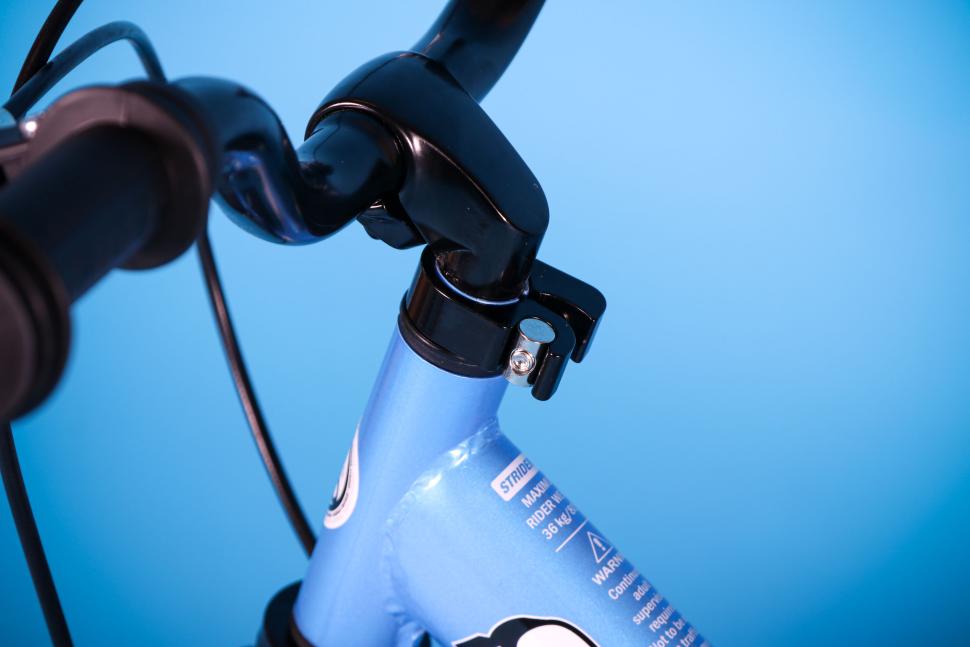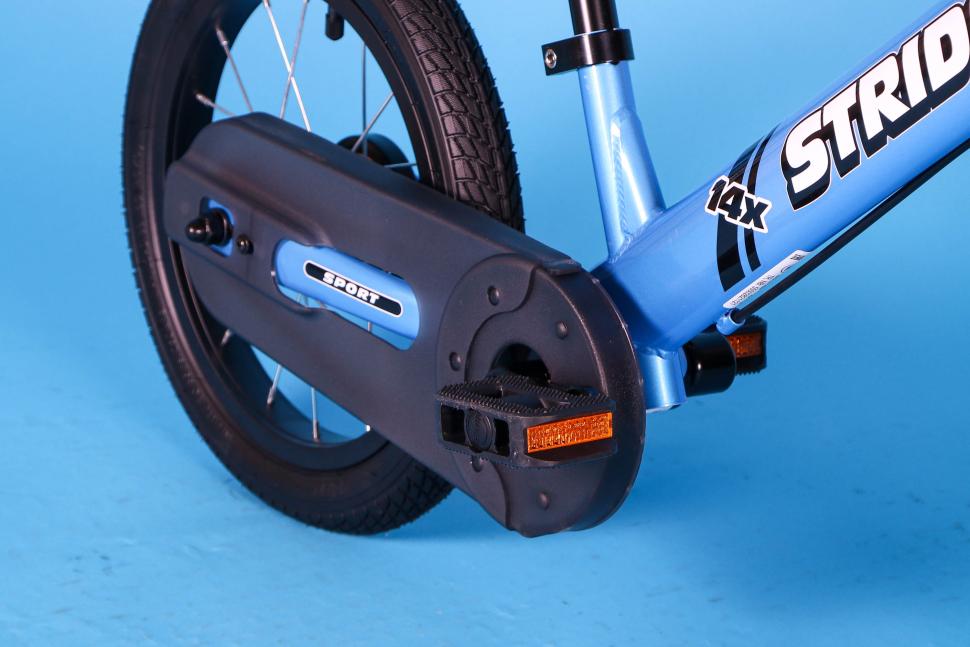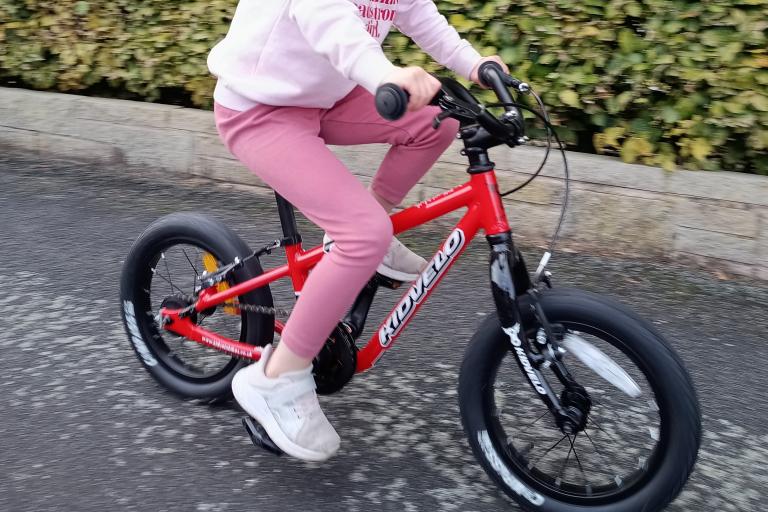- News
- Reviews
- Bikes
- Components
- Bar tape & grips
- Bottom brackets
- Brake & gear cables
- Brake & STI levers
- Brake pads & spares
- Brakes
- Cassettes & freewheels
- Chains
- Chainsets & chainrings
- Derailleurs - front
- Derailleurs - rear
- Forks
- Gear levers & shifters
- Groupsets
- Handlebars & extensions
- Headsets
- Hubs
- Inner tubes
- Pedals
- Quick releases & skewers
- Saddles
- Seatposts
- Stems
- Wheels
- Tyres
- Tubeless valves
- Accessories
- Accessories - misc
- Computer mounts
- Bags
- Bar ends
- Bike bags & cases
- Bottle cages
- Bottles
- Cameras
- Car racks
- Child seats
- Computers
- Glasses
- GPS units
- Helmets
- Lights - front
- Lights - rear
- Lights - sets
- Locks
- Mirrors
- Mudguards
- Racks
- Pumps & CO2 inflators
- Puncture kits
- Reflectives
- Smart watches
- Stands and racks
- Trailers
- Clothing
- Health, fitness and nutrition
- Tools and workshop
- Miscellaneous
- Buyers Guides
- Features
- Forum
- Recommends
- Podcast
review
 2024 Strider 14x Sport Balance Bike.jpg
2024 Strider 14x Sport Balance Bike.jpg£199.99
VERDICT:
A good bike for transitioning to pedals, but some of the components could be a bit better
Well-made main frame
Great for transitioning to pedal bikes
Some so-so components
Short cranks
Weight:
5,880g
Contact:
At road.cc every product is thoroughly tested for as long as it takes to get a proper insight into how well it works. Our reviewers are experienced cyclists that we trust to be objective. While we strive to ensure that opinions expressed are backed up by facts, reviews are by their nature an informed opinion, not a definitive verdict. We don't intentionally try to break anything (except locks) but we do try to look for weak points in any design. The overall score is not just an average of the other scores: it reflects both a product's function and value – with value determined by how a product compares with items of similar spec, quality, and price.
What the road.cc scores meanGood scores are more common than bad, because fortunately good products are more common than bad.
- Exceptional
- Excellent
- Very Good
- Good
- Quite good
- Average
- Not so good
- Poor
- Bad
- Appalling
The Strider 14x Sport Balance Bike is a decent convertible children's bike that my daughter enjoyed using. However, the saddle isn't the best quality seat you'll find, and while the Strider is great for the transition from balance bike to pedal-powered machine, the crank length and pedals mean it's probably not a long-term option as a pedal bike.
Cycling for kids today is very different from when I was a youngster. Back in the day, your first bike had pedals, was usually about six inches too big and gave you bruises all over your body. These days, kids can start with balance bikes and then gradually make their way up to 'real' bikes with fairly small increments between sizes.
The Strider 14x effectively fills the space between a balance bike and a pedal bike, with its 14in wheels putting it squarely in the 3+ age range, while providing a quick and easy way to attach pedals and convert it into a pedal bike when the time is right.
Construction
First off, this is predominantly a balance bike, so it has no frame triangle but has the step-through design favoured on smaller bikes, which allows youngsters to easily get their legs into the right position.
The lack of a top tube and seatstays means the tubing has to be considerably beefed up to cope with the extra forces, which inevitably makes the bike heavier than some of its competitors.
The air-filled tyres are an upgrade on the 12in Strider, which has foam tyres, which are less robust and harder to repair.
The bike has brakes too, which is an excellent addition for a balance bike as it allows your child to familiarise themselves with brakes before they begin using them at higher speeds when pedalling.
The front is a regular calliper brake while the rear is a rather old-school drum brake. My research suggests this has been retrofitted to conform with EU regulations and it isn't fitted to the model sold in the US.
Adjusting the bike is very simple. The handlebar is locked into place using a hex key, so all I need to do was to set it to my daughter's height and tighten it up. And it's the same for the seatpost too, though a thumb lever might have been a simpler solution for adjustments on the go, but it really isn't complicated.
The core build of the bike is durable thanks to the diameter of the tubes, but there are a few elements where I'd worry about their longevity, especially if the bike is left outside or dropped on the floor, which isn't unheard of when kids' bikes are concerned...
The saddle is foam with no wraparound to it. This means it's comfortable and malleable for children of different sizes, but I do feel it could rip and tear easily and wouldn't be surprised if there were chunks out of it within a year.
And I feel the front calliper, which is made of a sheet metal, could be bent in the event of a crash, and the levers themselves are plastic and will almost certainly break over time, especially with prolonged UV exposure.
Conversion
As I alluded to, one of the main selling points of this bike is that you can convert it from a balance bike to a pedal bike.
As a balance bike there is a small platform either side of the bottom bracket where your child can balance their feet when they're moving. Converting this to a pedal bike is just a case of undoing a single hex bolt which sits under the bottom bracket, taking off the platform that's there, then replacing it with the set of pedals.
You then add the chain guard, wrap the chain around the single sprocket on the rear wheel and it's done. In total the conversion was incredibly easy and took me just five minutes.
Once on it was easy for my daughter to understand how everything worked because I was only introducing a new way of moving forward. This bike is ideal for this transition because you're only introducing one transition to a bike they're already familiar with, which makes that transition much easier.
However, while this bike is very well suited for that transition, I wouldn't want to rely on it for a long-term pedal solution.
This is because there are a few unique elements – not least the length of the cranks and the shape of the pedals.
The crank arms are just 76mm, which means that once your child either wants to start going faster or once they've grown a couple of inches, they'll be too short.
Similarly, the pedals have been designed to match the shape of the standing platforms, which makes them long and thin and unlike a regular pedal. While this isn't necessarily a bad thing, it is advisable to make sure they are accustomed to the kind of pedals they will generally find on other pedal bikes as they grow up.
Weight
As mentioned, this bike has been beefed up because of its design, which has inevitably added some weight. It weighs in at 5.88kg, which is fairly heavy compared to some its competitors.
The Kidvelo Rookie 14 uses a traditional twin-triangle design and weighs just 4.7kg.
The Vitus 14 Kids Bike is a more substantial twin-triangle construction and a fully formed pedal bike without a balance option, though it does hit the scales at 6.1kg.
This does mean that with kids' bikes of similar prices and sizes, their weights can be all over the place.
Value
The £260 RRP for the balance bike and pedals is reasonable, though in my opinion it's outshone by the likes of the Kidvelo Rookie 14, which not only costs £235, but it also has better quality components and a lower weight.
The Vitus 14 Kids Bike was £299 when we tested it, though I feel this cost is justified by its higher quality components, which should ensure greater durability. That said, the 2021 model is presently on sale for just £239.
Our best kids' bikes buyer's guide rounds up our top choices as well as giving advice on choosing them.
Overall
I like the Strider 14x balance bike as a transitional bike that helps children move from balance bikes to pedalling, though I wouldn't consider it as a standalone pedal bike. My daughter really enjoyed using it in both its balance bike and pedalling modes, but there's no doubt that because of the crank length, pedal shape and component choices, once she gets bigger and faster I'd definitely want her on something more built-for-purpose.
Verdict
A good bike for transitioning to pedals, but some of the components could be a bit better
road.cc test report
Make and model: Strider 14x Sport Balance Bike (+ pedal kit £59.99)
Size tested: 14in wheels, 3-7 years
About the bike
List the components used to build up the bike.
Size: 14in Wheels
Weight:
Without Pedal Kit 5.7kg (12.5lb)
With Pedal Kit 6.9kg (15.1lb)
Fits Inseam: 40-58cm (16-23in)
Rider Height: Approx. 95-125cm (37-49in)
Rider Age: 3-7 years
Seat Height: 38-55cm (15-22in)
Maximum Rider Weight: 36kg (80lbs)
Frame and Fork: Steel
Head Set: Strider Custom Polymer
Steering Clamp: Binder Clamp (5mm Wrench Adjustable)
Seat Clamp: Easy Adjust Lever Clamp (No-Tool Adjustment)
Tubes: Schrader Valve Air Tube
Tires: 14in x 1.75in All-Purpose Tires
Wheels: Alloy Rims and Hubs, Chrome Spokes
Footrest: Included
Stem: Strider Custom Alloy/Steel, 25.4mm Bar Mount
Handlebar: Strider Custom 22.2mm, 68mm rise, 25.4mm mount, 4°backsweep/4°upsweep
Grips: Strider Custom 22.2mm
Seat: Strider Custom Performance Saddle
Seatpost: 22.2 x 293mm
Tools Included: 5 and 6mm Hex Wrenches
Assembly: Bike is 85% Assembled
CPSC Tested and Approved
Tell us what the bike is for and who it's aimed at. What do the manufacturers say about it? How does that compare to your own feelings about the bike?
Instant success. That's what we want kids to experience on the Strider 14x Sport. It starts as a balance bike, and when your child is ready to pedal, attach the Easy Ride Pedal Kit (sold separately). We know kids grow like crazy, so we made the seat and handlebars adjustable. It will continue to fit them through multiple growth spurts. The 14x is the best transitional biking experience for your child. Parents can sit back and watch their child's confidence and excitement skyrocket.
Where does this model sit in the range? Tell us briefly about the cheaper options and the more expensive options
The 14x tested is the larger of the two sizes in the range, with 12in the other size offered.
Frame and fork
Overall rating for frame and fork
8/10
Tell us about the build quality and finish of the frame and fork?
It is sturdy and likely to last. The single down tube/floating chainstay design needs to be made more sturdily than a double triangle design – and it is.
Tell us about the materials used in the frame and fork?
Both are constructed from steel.
How was the bike in terms of height and reach? How did it compare to other bikes of the same stated size?
It is easily adjustable, although a thumb lever on the seatpost would have made it easier to make adjustments when you're out and about.
Riding the bike
The drivetrain
Wheels and tyres
Controls
Rate the controls for performance:
7/10
They're fine, but they aren't designed to last as well as others I have tried
Rate the controls for durability:
5/10
The levers are plastic, the front callipers are made from sheet material – which is fine for stopping toddlers but they aren't going to last as well as other materials.
Tell us some more about the controls. Any particularly good or bad components? How would the controls work for larger or smaller riders?
These aren't the most robust components I've seen, which is a shame. The levers are all plastic, the saddle is non-covered foam and the drum brake and rear wheel aren't the highest quality compared with others at around the same price.
Your summary
Did you enjoy riding the bike? Yes
Would you consider buying the bike? Maybe
Would you recommend the bike to a friend? Maybe
How does the price compare to that of similar bikes in the market, including ones recently tested on road.cc?
The bike alone cost £199.99 with an additional £59.99 for the pedals – making £260 in total. This is okay, but I think the Strider is outshone by the likes of the Kidvelo Rookie 14, which is not only £25 cheaper but has better quality components and weighs less.
The Vitus 14 Kids Bike is more expensive at £299, but this is justified by the much higher quality that should ensure it lasts longer.
Rate the bike overall for performance:
7/10
Rate the bike overall for value:
6/10
Use this box to explain your overall score
It is a good balance bike that is an excellent way for kids to transition from a balance bike to a pedal bike. However, I do have questions about the quality of some of the components, particularly the brake levers and the saddle.
About the tester
Age: 35
I usually ride: CAAD13 My best bike is: Cannondale Supersix Evo
I've been riding for: 10-20 years I ride: Every day I would class myself as: Expert
I regularly do the following types of riding: commuting, club rides, sportives, general fitness riding, fixed/singlespeed,
George is the host of the road.cc podcast and has been writing for road.cc since 2014. He has reviewed everything from a saddle with a shark fin through to a set of glasses with a HUD and everything in between.
Although, ironically, spending more time writing and talking about cycling than on the bike nowadays, he still manages to do a couple of decent rides every week on his ever changing number of bikes.

















































Muddyfox tour 100's I've wide & flat feet plus there's the optional choice of using cleats with them...
Just doing the Lord's work in case anyone's interested in this product. This Mucoff Pump is a £100 rebrand of an £85 Rockbros rebrand of a £60...
You've watched ESPN before right ?
You forgot ignoring half the race to show awkward interviews with the riders' Proud Parents™ instead.
Obviously it means 'springing out of the bunch' on a critical sector. Or maybe it's referring to the time of year.
Car crashes through garden wall for second time in 18 months https://www.wiltshire999s.co.uk/car-crashes-garden-second-time/
Woman taken to hospital after flipping car onto roof in Trowbridge...
Its blindingly obvious from the image that the DKE of the buses include the mirrors which extend to nearly reach the edge of the tarmac pavement on...
It's sad when being very good at your job - any job - isn't enough to earn a decent living. It shouldn't be that way....
Bigly!